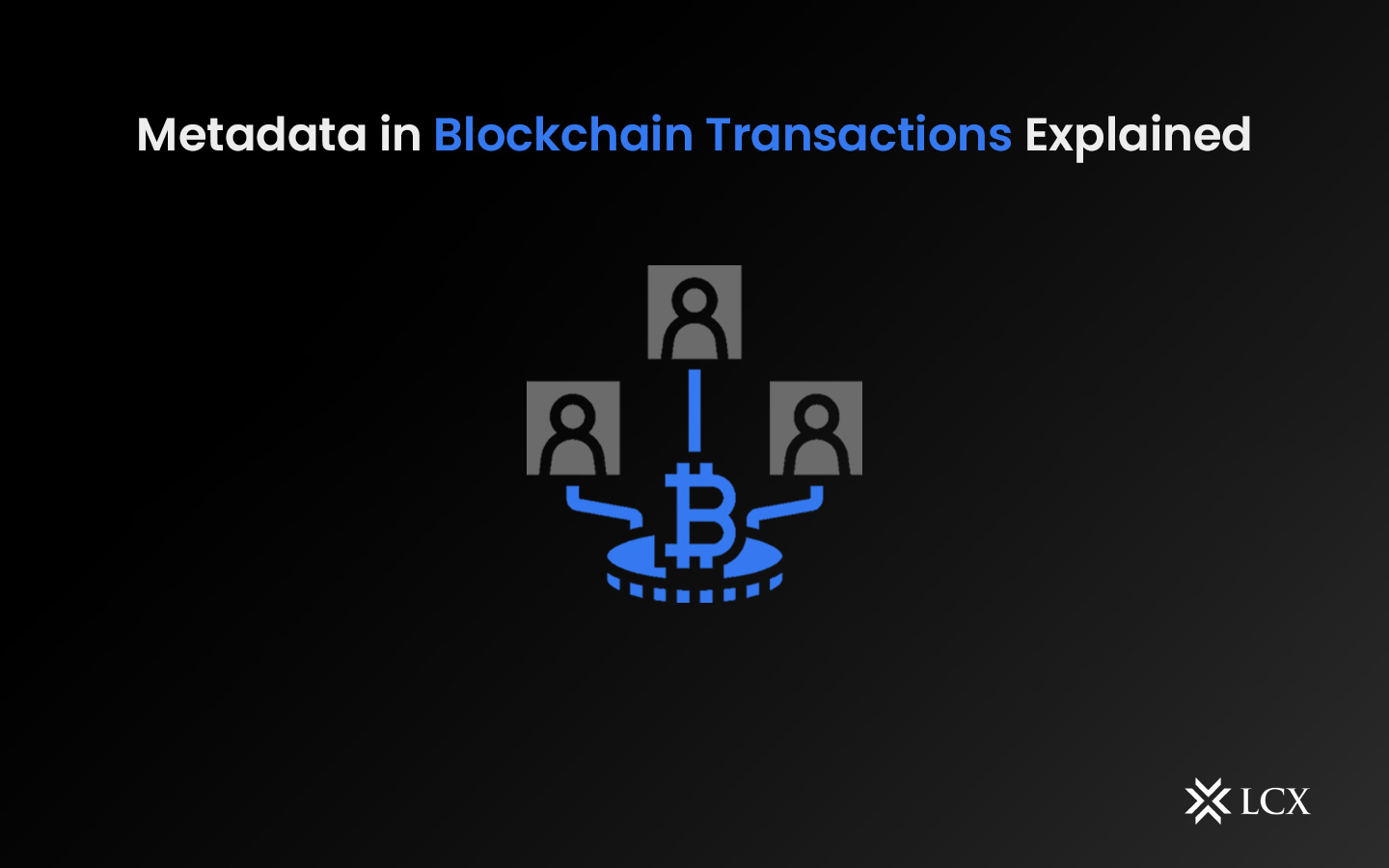Understanding Metadata in Blockchain Transactions
Metadata pertains to supplementary data or information that may be affixed to a cryptocurrency transaction recorded on a blockchain.
Metadata enables users to augment transactions with supplementary information or context, despite the fact that the primary purpose of a blockchain is to record and verify the transfer of digital assets, including cryptocurrencies such as Ether (ETH) and Bitcoin (BTC).
Metadata consists of information about data. It comprises information that, while not directly pertinent to the exchange of cryptocurrencies, may enhance the transaction’s functionality within the context of blockchain transactions.
Two primary categories of metadata are utilized in blockchain transactions:
On-Chain Metadata
Given that this metadata is appended to the blockchain in real-time, it is classified as transaction data. It is visible to anyone who has access to the blockchain. On-chain metadata comprises data such as transaction labels, annotations, and references to external contracts or documents.
Off-Chain Metadata
Although this information is alluded to in the transaction, it is not explicitly stored on the blockchain. Off-chain metadata may contain hyperlinks to supplementary materials, such as web URLs, files, or documents, that render the transaction more comprehensive. By utilizing off-chain metadata, participants can reduce the amount of congestion on the blockchain.
How on-Chain and off-Chain Metadata Are Stored
On-chain metadata, which consists of transaction particulars, smart contract code, and token properties, is stored and replicated in perpetuity across network nodes. It is an essential component of the blockchain’s data structure. An opposite approach is the storage of off-chain metadata externally via cryptographic references, which increases the flexibility and efficacy of the blockchain.
Native to the blockchain is a data structure that includes on-chain metadata. This data is replicated and stored permanently across all network nodes; it comprises a component of the blockchain’s ledger. The vast majority of on-chain metadata resides within the transactions themselves. Each transaction on the blockchain is accompanied by a payload containing relevant metadata. An example of on-chain metadata when transferring cryptocurrency between addresses is the inclusion of the sender, receiver, quantity, and transaction date.
Regarding smart contracts, the code and accompanying data are stored as on-chain metadata on the blockchain. This encompasses the contract’s functions, state variables, and associated data. Block headers contain metadata that is readily obtainable for the purpose of verification. Examples of such metadata include transaction IDs, block timestamps, and block numbers. The blockchain often stores metadata pertaining to the properties of tokens, such as the supply, symbol, and name, in the case of Ethereum’s ERC-721 and ERC-20.
Off-chain metadata, on the other hand, is not stored on the blockchain. Off-chain scalability solutions such as the Lightning Network, decentralized storage systems like the InterPlanetary File System (IPFS), and external databases are all viable locations for its storage. Blockchain references off-chain metadata via cryptographic hashes or pointers, thereby liberating space on the blockchain for the storage of larger or less critical data, reducing congestion, and granting applications that require dynamic or private information greater flexibility.
Examples of Metadata in Blockchain Transactions
Metadata comprises a wide range of information and capabilities, such as timestamps, transaction particulars, smart contract data, digital signatures, gas fees, IPFS links, Oracle information, and nonfungible token (NFT) metadata. These metadata elements empower the blockchain network to store and operate a variety of functions and data.
Timestamps
Each block in a blockchain is accompanied by a timestamp that indicates the exact instant it was appended to the chain. This metadata documents the precise moment a transaction takes place.
Transaction Details
A variety of metadata, including sender and recipient addresses, transaction quantities, and unique transaction IDs, may be appended to each transaction recorded on a blockchain.
Smart Contract Data
Metadata could potentially contain parameters and input data that are essential for the functioning of the contract during the execution of smart contracts on a blockchain.
Digital Signatures
Digital signatures are included in metadata to verify the authenticity of transactions and establish ownership.
Gas Fees
Metadata on blockchain platforms such as Ethereum may contain information pertaining to the petrol charges incurred during transaction processing. This information is necessary for miners and validators to effectively prioritize transactions.
InterPlanetary File System Links
In blockchain metadata, references to IPFS, a decentralized file storage system, are present. In order to gain access to the data stored on the blockchain, users must periodically retrieve a reference to the IPFS file, typically in the form of a hash. This method allows for the storage of substantial files, such as documents, videos, or images that pertain to on-chain assets like NFTs.
Oracles
Oracles are external services that grant access to real-world data for smart contracts. Information from these oracles may be incorporated into blockchain metadata in order to activate smart contracts.
Nonfungible Token Metadata
Metadata, including creators’ names, descriptions, and additional particulars pertaining to the digital or physical assets they symbolize, is frequently included in NFTs.
How to Add Metadata to a Blockchain Transaction?
In order to incorporate metadata into a blockchain transaction, a user may utilize a smart contract, which consists of predetermined terms inscribed within it and operates autonomously.
By employing Ethereum as an illustrative case, we can comprehend the process. Ethereum is renowned for its capability to incorporate metadata into transactions via smart contracts.
Create a Smart Contract
The creation of a smart contract is a prerequisite for the addition of metadata. Specific guidelines regarding the location and method of metadata storage are incorporated within this contractual agreement. The metadata may be stored in a defined variable, which is typically a string.
Interacting With the Smart Contract
Metadata must be appended to a blockchain transaction via a transaction transmitted by an individual to the smart contract. Wallet applications for Ethereum or libraries such as web3.js or ethers.js may be utilized for this purpose.
Verifying the Metadata
The metadata can be verified by any individual through interaction with the smart contract and by accessing the metadata variable subsequent to the transaction’s confirmation and inclusion in the blockchain. Nevertheless, when adding metadata to a blockchain transaction, it is critical to keep in mind that factors including petrol costs, security, and privacy must be assumed.
Use Cases of Blockchain Metadata
Metadata generated by blockchain technology is implemented across numerous sectors, such as healthcare, digital identity, smart contracts, and non-fungible tokens.
Supply Chain Management
Utilizing a blockchain to store product production, transportation, and quality-related metadata can assist organizations in enhancing transparency and traceability. For instance, a food manufacturer may maintain records pertaining to the origin of components, their progression through the supply chain, and assessments of their quality.
Ensuring regulatory compliance, addressing issues such as fraud or recalls, and confirming authenticity are all dependent on this information. Moreover, consumers can utilize this metadata to formulate informed judgments concerning the products they acquire.
Digital Identity and Authentication
Metadata on the blockchain can be utilized to preserve and safeguard credentials and confidential information. Individuals have control over their data and have the ability to grant or deny access to authorized parties; this reduces the likelihood of identity theft and privacy breaches. This technology can be utilized by educational institutions, governments, and businesses to expedite identification verification processes and enhance service security.
Smart Contracts
Smart contracts are an additional field in which blockchain metadata is indispensable. These self-executing contracts determine when and how to carry out a specific condition based on metadata. As an illustration, an insurance smart contract might employ meteorological data as metadata in order to promptly commence disbursements for policyholders who have been adversely affected by inclement weather.
Eligibility and interest rates for loans in the financial sector can be determined by loan agreements using metadata-maintained credit ratings and transaction histories. This enables the industry to conduct lending procedures in a more streamlined and automated fashion.
Nonfungible Tokens and Digital Assets
NFTs and digital assets frequently employ blockchain data to assign significance and value to digital artifacts, artwork, and assets. Metadata pertains to details such as the characteristics of the digital item, the originator, and the ownership history. This knowledge can significantly benefit provenance tracing, art authentication, and the development of decentralized applications (DApps) that are built upon NFTs.
Healthcare Records and Data Security
In addition, the healthcare industry is employing blockchain metadata to ensure data integrity and secure the management of patient records. Metadata can be utilized to retain medical histories, patient consent forms, and data access logs, thereby enhancing the confidentiality and security of health information. In addition, it enables communication among diverse healthcare systems and expedites the acquisition of critical medical information by emergency responders.
Challenges Associated With Blockchain Metadata and Way Forward
Addressing obstacles related to blockchain metadata, such as concerns regarding scalability, data security, and Oracle dependability, is imperative for the long-term progress of technology and its extensive implementation.
Scalability and storage costs are significant considerations due to the fact that as the scale of blockchain networks increases, they may experience a decline in efficiency and require more resources. The storage of massive amounts of data on the blockchain could place a burden on the network’s architecture and heighten the danger of centralization.
Data privacy and security are additional concerns, especially when handling private or sensitive information. Privacy regulations may be in conflict with the transparency of blockchain technology; therefore, implementation and design must be approached with care. In addition, malicious or erroneous data inputs may compromise the dependability of blockchain applications and smart contracts that rely on oracles to retrieve external data.
It is imperative to tackle these obstacles in order to ensure the ongoing progress and widespread implementation of blockchain technology across diverse sectors. To surmount these challenges in blockchain metadata, a diversified approach is required. To mitigate scalability challenges, developers may consider investigating layer-2 solutions and sharding techniques as a means to offload specific data from the primary chain.
The utilization of permissioned blockchains and encryption can enhance the privacy and security of sensitive data. An additional layer of security can be applied to Oracle by utilizing multiple data sources for reputation and validation mechanisms. In light of this, blockchain metadata can be rendered more secure and efficient through the implementation of robust security protocols, innovative technology, and meticulous design.










